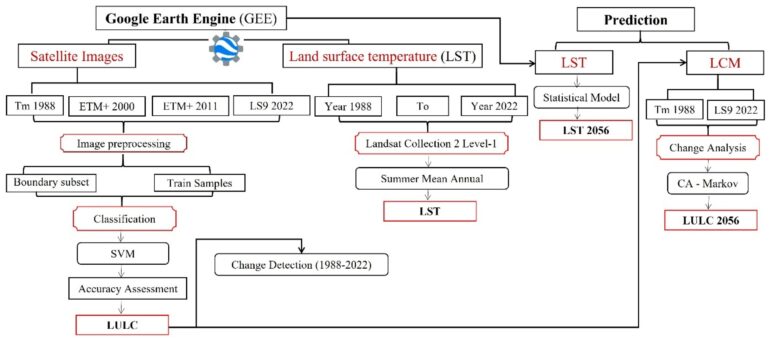TL;DR:
- Researchers at RUDN University examined the influence of urbanization and human activity on soil surface temperatures in Egypt.
- Urbanization leads to the “urban heat island effect,” causing urban areas to become significantly warmer than rural ones.
- Satellite imagery from the Landsat program (1972-2021) and machine learning were used to project temperature changes until 2056.
- The study identified six surface types in the research area, with urban surfaces expanding by 6,283 acres since 1988.
- Empty land decreased from 28.3% to 0.7%, while the average temperature rose from 32.4℃ to 33.6℃, with a projected increase to 36℃ by 2056.
- Agricultural land is expected to decrease by 11.48%, urban development to increase by 4.6%, and fish farms by 6.1% by 2056.
- Urgent action is needed to curb urban sprawl and address rising temperatures.
Main AI News:
Urbanization and its effects on the environment have become increasingly important topics of discussion in recent years. Researchers at RUDN University have delved into this issue by focusing on the case of Egypt. The study, which was recently published in Sustainability, offers insights into how urbanization and human activity are influencing soil surface temperatures.
In an arid climate, rural areas typically act as natural refrigerators, experiencing less surface heat and helping to maintain overall temperature equilibrium. However, the expansion of cities has led to a reduction in the size of these rural areas. This shift has significant consequences for temperature regulation.
The phenomenon known as the “urban heat island effect” is a direct result of urbanization. As natural landscapes transform into concrete and asphalt jungles, these urban areas absorb and radiate more heat than their natural counterparts. Consequently, urban regions have become notably warmer than rural areas, causing concerns about temperature rise and climate change mitigation.
Dr. Dmitry Kucher, the head of the Scientific Center for Research, Integrated Design, and Development of Urban and Agricultural Development at RUDN University, emphasized the importance of understanding the intricate relationship between human activities, urbanization, and temperature fluctuations. “Mitigating the consequences of climate change,” he asserted, “requires a comprehensive understanding of these dynamics.”
To gain insight into the long-term effects of urbanization, environmentalists conducted research in the governorate of Kafr el-Sheikh in northern Egypt. Using satellite imagery from the Landsat program, which spans from 1972 to 2021, researchers compiled a vast dataset. This data was then meticulously analyzed using machine learning techniques to create a predictive simulation extending up to 2056.
The study identified six distinct surface types within the research area: cultivated land, empty land, urban surfaces, natural vegetation, Lake Burullus, and fish farms. Since 1988, the expansion of urban surfaces has led to an increase of 6,283 acres, while agricultural land has dwindled by 3,950 acres.
One striking change has been the significant decrease in empty land, which plummeted from 28.3% to a mere 0.7%. This shift is a result of urban development, agricultural land expansion, and the emergence of fish farms. Concurrently, the average temperature in the region has risen from 32.4℃ to 33.6℃. Projections suggest that by 2056, temperatures could surge by an additional 3 degrees, reaching a scorching 36℃. In this trajectory, agricultural land is expected to decrease by 11.48%, while urban development and fish farms are projected to increase by 4.6% and 6.1%, respectively.
Dr. Kucher emphasized the importance of these findings, stating, “We have successfully predicted changes in land use and surface temperatures. Urban sprawl poses a significant threat to the environment, with temperature fluctuations primarily driven by human activity. Local authorities must prioritize policies that curb urban land expansion and address rising temperatures.“
Conclusion:
The research highlights the detrimental impact of urbanization on temperature regulation in Egypt. This has significant implications for the market, as it underscores the need for sustainable urban development and environmentally conscious policies. Companies operating in construction, real estate, and agriculture should consider the long-term consequences of urban sprawl and explore eco-friendly solutions to mitigate temperature rise and its associated challenges.

